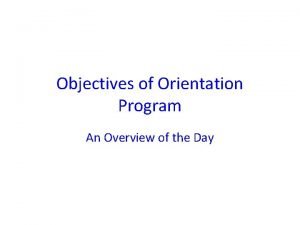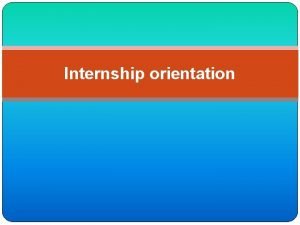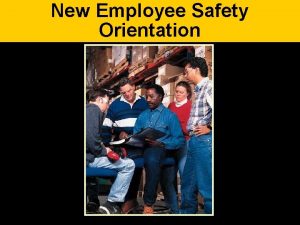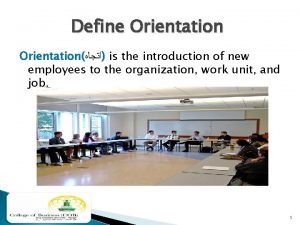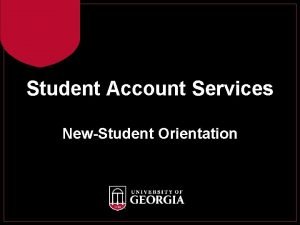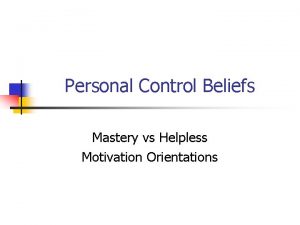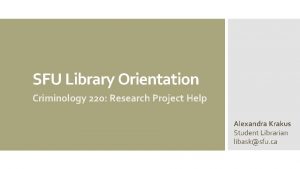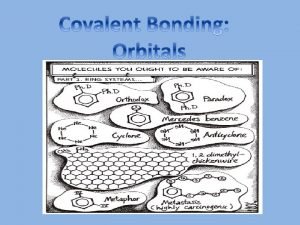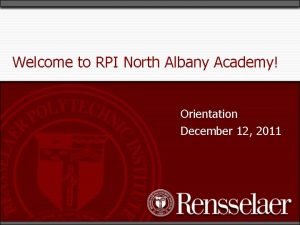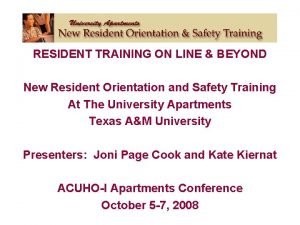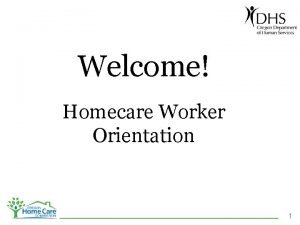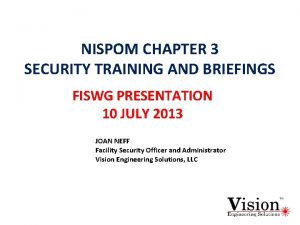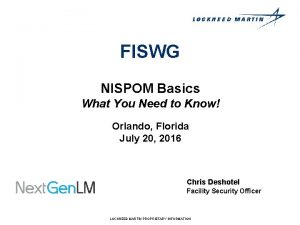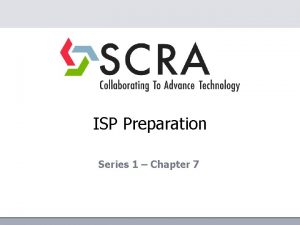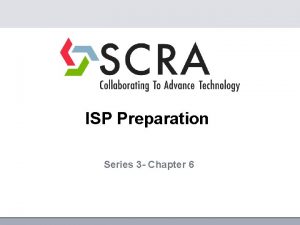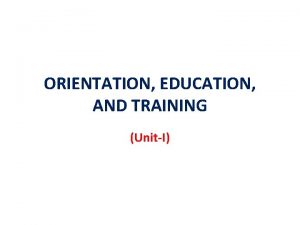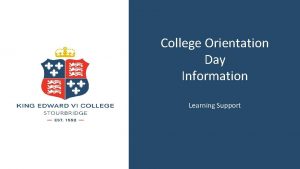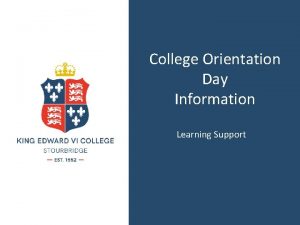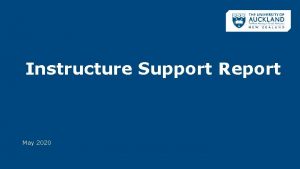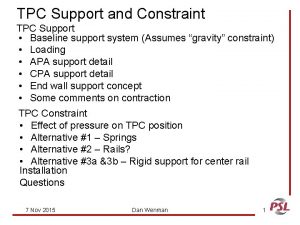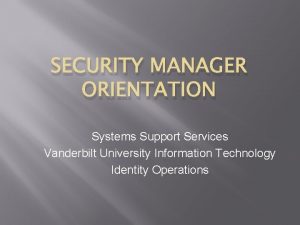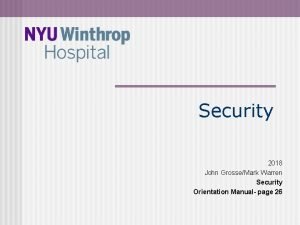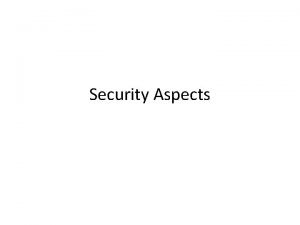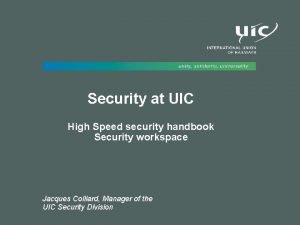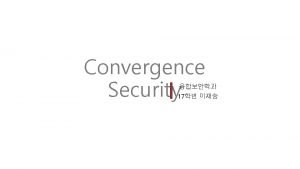SECURITY ORIENTATION NISPOM SECURITY ORIENTATION IN SUPPORT OF

































- Slides: 33

SECURITY ORIENTATION - NISPOM SECURITY ORIENTATION IN SUPPORT OF THE NATIONAL INDUSTRIAL SECURITY PROGRAM 1

SECURITY ORIENTATION - NISPOM 2013 Security Orientation 2

SECURITY ORIENTATION - NISPOM Administrative Matters If you are taking the on-line version of this briefing (www. allqsecure. com), you will be required to submit a record of completion. Once submitted your security representative will receive an email verifying that you have completed your training session. A record of completion will also be maintained in your individual security file. If you are attending a “live” briefing, please be sure to complete the sign in record. If you would like a copy of this briefing, please visit www. allqsecure. com and download the latest version! (Hey – its FREE!) 2013 Security Orientation 3

SECURITY ORIENTATION - NISPOM SO…What’s this briefing all about? • • • PRIMARILY it is about your responsibilities when dealing with our country’s classified information. Safeguarding classified information is a serious matter … and there will be many references to laws, regulations, directives, contracts, etc. as we proceed. However, the Industrial Security program involves more than classified information safeguarding …It is also involves: • Sensitive But Unclassified Information • Access to sensitive systems and areas (IT systems; facilities; non-public areas) • Information Management • Proprietary or other sensitive information (bids, proposals; projects, relationships, trade secrets, etc. ) • Personal conduct • Responsibility • Its also about the our Security Program 2013 Security Orientation 4

SECURITY ORIENTATION - NISPOM Contents: • • Introduction to the Industrial Security Program Threat Awareness Briefing Defensive Security Briefing An overview of the security classification system; Reporting obligations and requirements. Job specific security procedures and duties Company Security and Related Programs 2013 Security Orientation 5

SECURITY ORIENTATION - NISPOM Introduction As a Government contractor. . . – We are bound by Executive Order 12829, National Industrial Security Program, which establishes rules and regulations to properly protect and control all classified material in our possession or under our immediate control. – We have been granted a Facility Clearance by the Defense Industrial Security Clearance Office – a division of the Defense Security Service (a. k. a. Cognizant Security Agency) – Employees and to some extent consultants requiring access to classified information in order to perform work on classified contracts are granted “eligibility” by DSS and “access” by the Company (in conjunction with the needs of our government client). – Background Investigations are conducted by OPM (or their contractors) based upon the employee’s “Need to Know” and the company’s security requirements imposed by contract. 2013 Security Orientation 6

SECURITY ORIENTATION - NISPOM The Company Facility Clearance • A Facility Clearance (FCL) is a determination that a company is eligible for access to classified information or award of a classified contract. This process involves an evaluation of the corporate organization; key leadership; outside corporate relationships; foreign influence, etc. • In other words, an FCL means that a company (or better said, its cleared personnel) may have access to classified information based on a government need and at a government approved location. • An ability to STORE classified information or process classified information requires separate reviews and authorizations. • Companies are required to complete a DOD SECURITY AGREEMENT (DD Form 441) which outlines its security responsibilities. The Industrial Security Facility Database maintains data on all Do. D cleared companies. FSOs and other authorized persons may access the database to verify a company’s FCL. Companies are identified through their “CAGE Code” 2013 Security Orientation 7

SECURITY ORIENTATION - NISPOM Sample ISFD Verification 1 ABC 1 BESTCOMPANYEVER 123 4 th Street Suite 789 Alexandria, VA 22315 I. M. SECURE 1 -800 -SEC-CALL 2013 Security Orientation 8

SECURITY ORIENTATION - NISPOM Personnel Clearances Once the company receives its FCL, select employees can be granted access to classified information based upon: ELIGIBILITY Granted by CSA + NEED TO KNOW INDOCTRINATION + Established by Contract Completed by Company Favorable background inv. DD 254 requirements Eligibility & Contract Limits TS: SSBI Access to all up to TS; SCI eligible TS S: SSBI Access up to Secret S IT Levels: Sensitivity levels Based on systems and access rqmts IT Level I, II or III Suitability: NACI Non-Sensitive None – “Favorable” Other As per agency NATO; COMSEC, Etc. 2013 Security Orientation 9

SECURITY ORIENTATION - NISPOM The Non-Disclosure Agreement 2013 Security Orientation A SPECIAL TRUST IS PLACED IN YOU LIFELONG AGREEMENT YOU MUST PROTECT FROM UNAUTHORIZED DISCLOSURE SERIOUS CONSEQUENCES FOR NONCOMPLIANCE 10

SECURITY ORIENTATION - NISPOM Industrial Security Oversight Multi-Level Relationships The End User establishes its security requirements (hopefully together with their IS Group) The Contracting Officer issues contract to company with DD 254 (as per End User Security Requirements). The Company FSO and PM evaluate security requirements. FSO submits required documentation to End User for access authorization. Company PM evaluates contract performance (including security compliance) on site DSS Evaluates Company security performance together with the End User security office / PM. End User Security Office evaluates project security performance – both government employee and contractor 2013 Security Orientation 11

SECURITY ORIENTATION - NISPOM 2013 Security Orientation 12

SECURITY ORIENTATION - NISPOM The Threats America's role as the dominant political, economic, and military force in the world makes it the Number 1 target foreign espionage. It’s not just intelligence sources that are targeting us. Other sources of the threat to classified and other protected information include: • • • Foreign or multinational corporations. Foreign government-sponsored educational and scientific institutions. Freelance agents (some of whom are unemployed former intelligence officers). Computer hackers. Terrorist organizations. Revolutionary groups. Extremist ethnic or religious organizations. Drug syndicates. Organized crime. 2013 Security Orientation 13

SECURITY ORIENTATION - NISPOM DSS Intel tells us that … In FY 11, suspicious network activity (SNA) was the most prevalent collection MO for entities originating from East Asia and the Pacific; SNA figured no more prominently than fifth in any other region. Due to the nature of SNA, it remains difficult to attribute such collection attempts to an entity or even to a region of origin. The top four most targeted technology categories in FY 11— information systems (IS); lasers, optics, and sensors (LO&S); aeronautics systems; and electronics— remained unchanged. 14

SECURITY ORIENTATION - NISPOM DSS Tells Us that … • Technologies resident in U. S. cleared industry remain highly sought after. Foreign intelligence entities (FIEs) continue to expand their collection networks and activities. These networks are growing like a malignant vine. • This ongoing theft—FIEs’ pilfering of U. S. technologies from cleared industry—could reduce or even end advantages in military capabilities the United States possesses over potential adversaries, thereby adversely affecting U. S. battlefield dominance. It also could strangle U. S economic growth, vitiating the nation’s economic health. • The overall number of reports submitted by cleared industry to the Defense Security Service (DSS) in FY 11 increased by nearly 65 percent over FY 10, and the number that actually became suspicious contact reports (SCRs) increased by 75 percent, likely due in large part to increased awareness and reporting by industry. 15

SECURITY ORIENTATION - NISPOM The Threat – Economic & Industrial Espionage Who Is Doing It? Due to foreign policy considerations and the need to protect sources, the U. S. Government does not publicly name the countries that are most active in conducting espionage against the United States. However, several European and Asian countries have stated openly that their national intelligence services collect economic intelligence to benefit their industries at the expense of foreign competition. Considerable information on this subject is available in public sources. What Are They After? It would be nice to know exactly what classified, proprietary or other sensitive information foreign countries are trying to collect, so that we could then concentrate on protecting that information which is most at risk. Unfortunately, waiting for that kind of specific information before taking appropriate security measures would usually mean locking the barn door after the horses have left. March 7, 2008: a Reston, VA company, pleads guilty in federal court to illegally exporting "controlled power amplifiers, " which have military applications 16 2013 Security Orientation

SECURITY ORIENTATION - NISPOM The Threat (Cont’d) • • • The increasing value of technology and trade secrets in the global and domestic marketplaces, and the temporary nature of many high-tech employments, have increased both the opportunities and the incentives for economic espionage. The rapid expansion in foreign trade, travel, and personal relationships of all kinds, now makes it easier than ever for insiders to establish contact with potential buyers of classified and other protected information. The development of automated networks and the ease with which large quantities of data can be downloaded from those networks and stored and transmitted to others increases exponentially the amount of damage that can be done by a single insider who betrays his or her trust. 2013 Security Orientation 17

SECURITY ORIENTATION - NISPOM The Threat – Economic & Industrial Espionage Foreign governments’ continued ability to acquire state-of-the-art U. S. technology at little or no expense has undermined U. S. national security by enabling foreign firms to push aside U. S. businesses in the marketplace and by eroding the U. S. military lead. A clear line must be drawn to protect information that is: • classified, or • subject to export controls because it concerns militarily critical technologies, or • proprietary information that is the intellectual property of a specific firm or individual. CASE STUDY: “IF AT FIRST YOU DON’T SUCCEED…” In September 2011, a Massachusetts-based cleared contractor received a request for an export-controlled amplifier from a company based in East Asia and the Pacific. The company did not state the intended end user or end use in the initial contact. Reporting from the same cleared contractor indicated that the model of amplifier requested had been the subject of numerous previous requests, including several from companies located in the U. S. and third countries. Several of these requests listed other East Asia and the Pacific actors as the intended end users. Reporting from other cleared contractors cited several of the entities requesting the equipment as having contacted separate facilities seeking other particular items of sensitive, dual-use technologies. IC reporting identified several of those entities as suspected technology brokers for East Asia and the Pacific actors and enterprises associated with multiple military development projects. 2013 Security Orientation 18

SECURITY ORIENTATION - NISPOM “Globalization and growing economic interdependence, while creating new levels of wealth and opportunity, also create a web of interrelated vulnerabilities and spread risks even further… Department of Defense National Defense Strategy July, 2008 2013 Security Orientation 19

SECURITY ORIENTATION - NISPOM Threat Awareness … Information concerning troop rotations, locations, equipment; and technology is classified for a reason. Unauthorized release of this information can have a detrimental effect on the Warfighters’ survivability. Let us not forget who we support. 2013 Security Orientation 20

SECURITY ORIENTATION - NISPOM How do we defend against threats? 2013 Security Orientation 21

SECURITY ORIENTATION - NISPOM First we need to know what we are protecting! Regarding national security information, it is generally fairly simple to recognize… TOP SECRET FOR OFFICIAL USE ONLY (FOUO) Sensitive But Unclassified (SBU) Sensitive Compartmented Information (SCI) CONFIDENTIAL NATO COSMIC COMSEC CNWDI RESTRICTED TOP SECRET/SI/TK/HS/G/B– ANIMAL HOUSE SPECIAL ACCESS REQUIRED 2013 Security Orientation 22

SECURITY ORIENTATION - NISPOM SECRET National Security Information. Unauthorized Disclosure Subject to Criminal Sanctions. CONFIDENTIAL CLASSIFIED COVER SHEETS 23

SECURITY ORIENTATION - NISPOM Classified Information: üMust never be left unattended. üMust never be discussed in public places. üMust be discussed on secure telephones or sent via secure faxes. üMust be under the control of an authorized person. üStored in an approved storage container. üNever be processed on your computer unless approved by the U. S. Government. 24

SECURITY ORIENTATION - NISPOM Discussing Classified Information It is your personal responsibility to know that the person you are dealing with is both properly cleared and has a need to know. You must never reveal or discuss classified information with anyone other than those that are properly cleared and have a need to know. 25

SECURITY ORIENTATION - NISPOM You must report… Loss, compromise, (or suspected loss or compromise) of classified or proprietary information, This includes evidence of tampering with a container used for storage of classified information. If you find an unlocked security container which is unguarded or left unlocked after-hours. 26

SECURITY ORIENTATION - NISPOM You must report… If a member of your immediate family (or your spouses immediate family) takes up residence outside the United States, or if you acquire relatives (through marriage) who are residents or citizens of a foreign country. AY M CI NG R S / I U TS ORT YO NG EP ITH O. I D LR W FS L O A K R L H ION HEC T O E N DIT. C IEN N S CL O AD T S N R T PE AVE EME MEN H IR RN U E Q V RE GO Immediately report any employment by a foreign interest. 27

SECURITY ORIENTATION - NISPOM Foreign Interest: A foreign government – or Any business enterprise organized under the laws of any country other than the U. S. or its possessions - or Any form of business enterprise which is owned or controlled by a foreign government, firm, corporation or person - or Any person who is not a citizen or national of the U. S. 28

SECURITY ORIENTATION - NISPOM Protecting Yourself in an Uncertain World • When traveling on company business or for personal reasons, plan and prepare. • Develop a personal travel plan and give it to your office and family. • Learn about the culture, customs and laws of countries you visit. • Visit the Department of State Web Site for info on Threat Advisories. • Coordinate with your FSO for overseas Company travel • Don’t forget an Anti-Terrorism / Force Protection Briefing and Travel Briefing. AY M /SCI G S T ING TIN D R L O O P RE OUR EL H Y L N A H N O TION ECK WIT SO. I D PERS D A CH OR F T HAVE MENTS. N E CLI RE T I N U E Q RE RNM E V O G 29

SECURITY ORIENTATION - NISPOM Security Violations Bring Disciplinary Actions For Minor Violations Action MAY Include: • Verbal Counseling • Written Counseling • Suspension/Termination For Major Violations Action MAY Include: • Same as minor violations • Loss of security clearance • Arrest • Imprisonment or fines 30

SECURITY ORIENTATION - NISPOM Qivliq Security Program • • • Common Security Services Agreements One FSO for all – supported by Sector Security Staff Federal Services Group Federal Products Group Others Services Provided: – – DD 254 reviews (for contract performance); Sub DD 254 issuance Personnel Security applications (e. QIP) JPAS / VAR submissions Training, etc. 2013 Security Orientation 31

SECURITY ORIENTATION - NISPOM Report It! (Hotline Numbers) • • • Federal Bureau of Investigation The FBI has 56 field offices. The phone number of the nearest office is listed under United States Government in your local phone book. Defense Department 1 -800 -424 -9098, (703) 693 -5080 Defense Security Service (DSS) (Defense contractors report suspect incidents to local DSS industrial security representative) Defense Intelligence Agency (703) 907 -1307 National Security Agency (301) 688 -6911 Department of Army 1 -800 -CALLSPY Naval Criminal investigative Service 1 -800 -543 -NAVY Air Force Office of Special Investigations (202)767 -5199 Central Intelligence Agency Office of the Inspector General (703) 874 -2600 2013 Security Orientation • • • Department of Energy (202) 586 -1247 U. S. Nuclear Regulatory Commission Office of the Inspector General 1 -800 -233 -3497 US Customs Service 1 -800 -BE-ALERT Department of Commerce/Office of Export Enforcement (202) 482 -1208 or 1 -800 -424 -2980 (to report suspicious targeting of US export-controlled commodities) Department of State Bureau of Diplomatic Security (202) 663 -0739 When traveling overseas, suspect incidents should be reported to the Regional Security Officer (RSO) or Post Security Officer (PSO) at the nearest U. S. diplomatic facility. 32

SECURITY ORIENTATION - NISPOM Questions? Give us a call or submit your question via the briefing RESPONSE FORM. 2013 Security Orientation 33
 Dss self-inspection report example
Dss self-inspection report example Private securit
Private securit Polycentric ethnocentric geocentric regiocentric
Polycentric ethnocentric geocentric regiocentric Minor and major details
Minor and major details General security
General security E commerce security meaning
E commerce security meaning Explain about visa international security mode
Explain about visa international security mode Building security software
Building security software Osi model security architecture
Osi model security architecture Electronic mail security in network security
Electronic mail security in network security Security guide to network security fundamentals
Security guide to network security fundamentals Guide to network security
Guide to network security Nstissc security model in information security
Nstissc security model in information security Security guide to network security fundamentals
Security guide to network security fundamentals Wireless security in cryptography and network security
Wireless security in cryptography and network security Objectives of orientation program for students
Objectives of orientation program for students Orientation objectives
Orientation objectives Internship orientation
Internship orientation New teacher orientation presentation
New teacher orientation presentation Employee safety orientation quiz answers
Employee safety orientation quiz answers Fau orientation
Fau orientation Naive hedonistic orientation
Naive hedonistic orientation Orientation kit meaning
Orientation kit meaning Uga bursar
Uga bursar Eckan head start
Eckan head start Georgia state orientation
Georgia state orientation Helpless orientation
Helpless orientation Apa citation sfu
Apa citation sfu Brick orientation
Brick orientation Hybridization is the combination of two or more
Hybridization is the combination of two or more The albany academy
The albany academy Telephone 911
Telephone 911 Termes relatifs à l'orientation anatomique
Termes relatifs à l'orientation anatomique Oregon homecare workers benefit trust
Oregon homecare workers benefit trust















